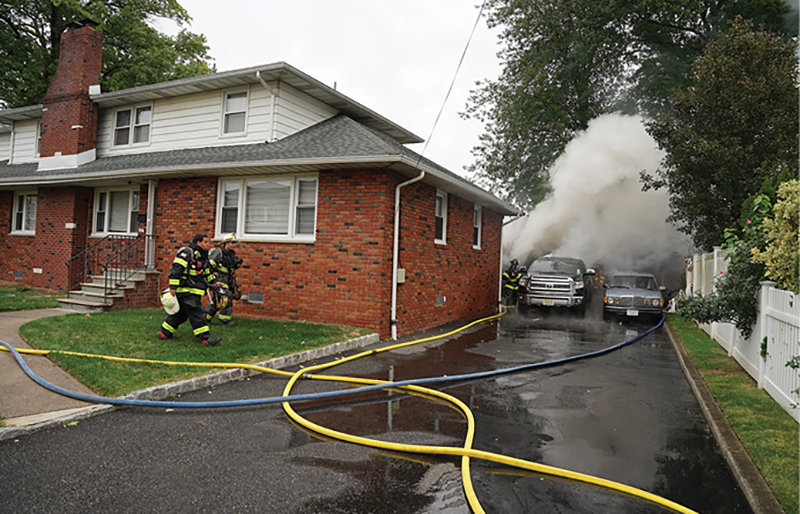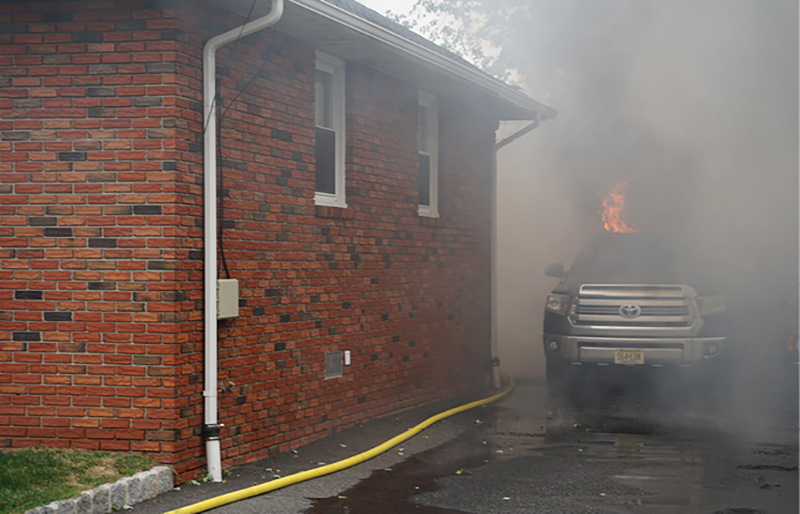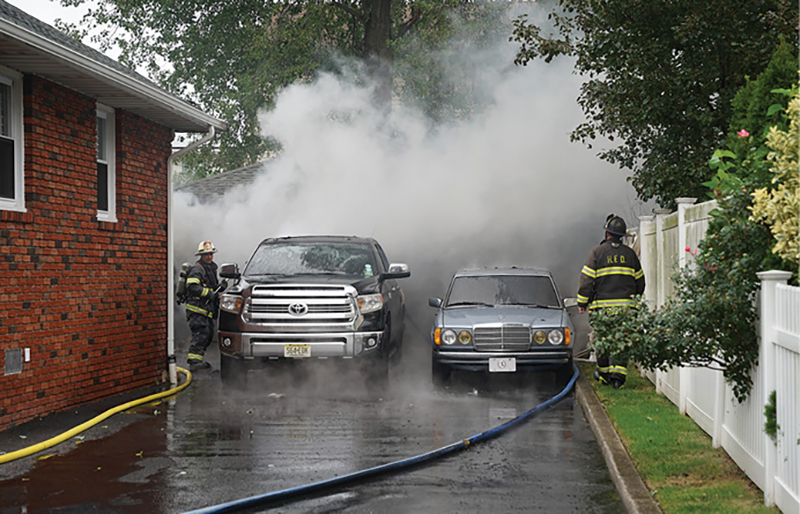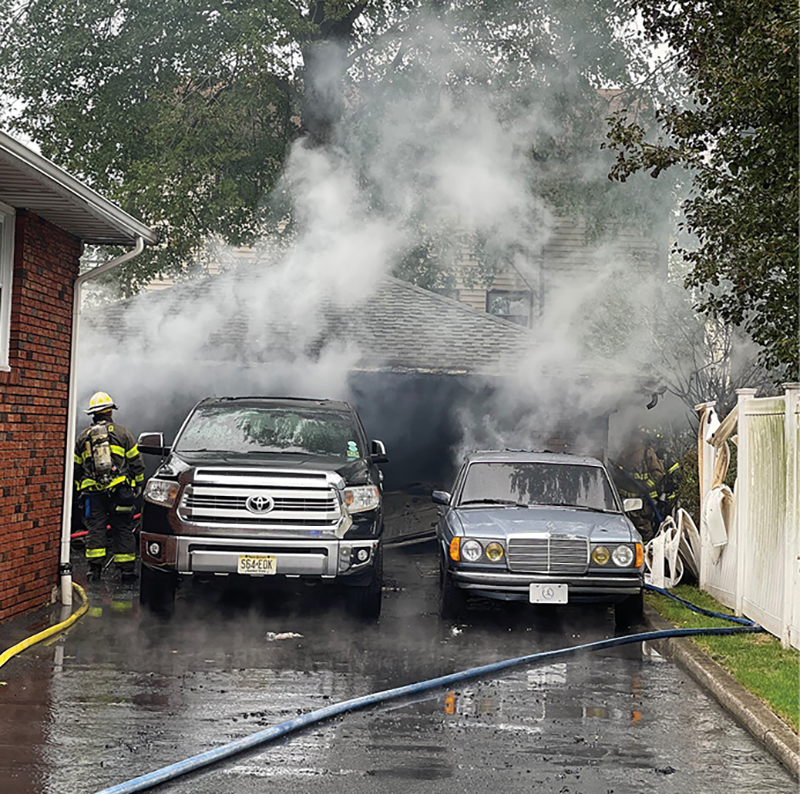FIRE FOCUS | by MICHAEL N. CIAMPO
Receiving a phone alarm for a fire in a garage can give firefighters minimal information on the type of garage they may encounter. All types of garages exist, from the gas station to the commercial repair or body shop to the bus or truck depot that’s constructed with brick or block walls and wooden roof joists or steel bar joists. At residential structures, garages can be located under a dwelling, alongside it, in a rear yard, or attached by a breezeway or mudroom.
Training Bulletin: Garage and Attic Fires
If we’re lucky enough to have a computer-aided dispatch program or a device that allows us to see the structure, it’s best to try and take a look at it prior to our arrival. This way, we’ll have some vision of what type of structure we’re responding to, the street conditions (i.e., overhead wires, trees, setback from the street), and an overhead view for a full picture of the building’s footprint. If an incident commander (IC) can do this, it will enhance the size-up, especially if the yard’s characteristics don’t allow a full 360º size-up to be completed.
The Little Ferry (NJ) Fire Department received a midday call for a garage fire in a residential neighborhood. Like many volunteer fire departments across the country, Little Ferry relies on adjoining towns for mutual aid during the day. Many departments have set up automatic responses from neighboring towns for daytime hours when most of their volunteers are at work and available staffing is low. Realizing this situation and seeing the working fire once on scene, the IC at this fire immediately struck a second-alarm assignment, which brought additional staffing and resources to the scene.

(1) It may be difficult to get a full 360° size-up of a garage because of its position and vehicles or fences blocking access. (Photos by Tony Greco.)

(2) Stretch two hoselines for fire attack because of the hazards present at these structures.
With heavy smoke drifting down to the driveway’s ground level between the dwelling and garage on arrival, it made it that much more difficult to perform a comprehensive size-up. To formulate the plan of attack, it was imperative for the IC to find the fire’s location. The 360° size-up revealed that the fire was in a detached garage just to the rear of the house. Luckily, it wasn’t attached to the dwelling, but there were significant exposure problems. Unfortunately, the radiant heat from the fire was already exposing the home, two vehicles parked in front of the garage, and a vinyl fence running along the property line. These items were all in danger of igniting from the escaping flames and radiant heat being released from the fire.
With a quick fire attack and exposure protection dire necessities, members stretched two 1¾-inch hoselines down the driveway toward the garage. One line would focus on attacking the main body of fire in the garage, and the other would protect the home and vehicles from igniting. With some minor extension occurring to the home, members stretched a third hoseline to the front door to cover the interior of the home in case things became worse and had enough length to cover the entire interior.
The two hoselines stretched down the driveway were able to knock down the fire in the garage and prevent any further extension to the home. The second line was able to alternate its stream between the main body of fire and the extension while also playing it directly onto the vehicles.
After the fire was knocked down, the tedious task of overhauling began. Units had to be aware of the structural integrity of the garage’s roof joists and the stability of the garage door sitting overhead. Once members completed overhaul and a thorough washdown, the fire was placed under control.
The rapid deployment of hoselines to the garage enabled members to knock down the fire quickly and limit the fire extension to the home and vehicles. Establishing a secure source of water from a hydrant also allowed the two hoselines to be fed with an uninterrupted supply. Fast and efficient water kept this garage fire from rapidly spiraling out of control and engulfing the home and automobiles. In addition, calling for mutual aid early in the operation allowed sufficient firefighters to be on scene to assist in the firefight and overhaul operations.

(3) When vehicles and the garage are both involved, firefighters must use caution. Chocking the tires should be a priority for vehicle fires.

(4) Vehicles positioned in the driveway can hamper firefighters’ efforts to transport ladders and stretch and operate hoselines. Firefighters should be positioned to prevent the hoseline getting caught on a car tire.
Garage Fire Characteristics
All firefighters must realize the fire load of the materials stored in a garage. Vehicles (gas, hybrid, compressed natural gas, diesel fuel, lithium-ion batteries), lawn mowers, snow blowers, power tools, and recreational vehicles all have flammable liquids and gases in them. Propane tanks for gas barbecue grills, acetylene for torches, and chlorine for pools are other hazardous materials that can often be found stored here.
Use the reach of the stream to knock down the bulk of the fire to keep members safe as they enter this hazardous environment. The stream may have to be directed onto tanks to cool them and prevent a boiling-liquid, expanding-vapor explosion (BLEVE). It may also have to be directed onto an exposure and then the main fire to limit the fire spread.
When applying water to protect an exposure or vehicle, ensure the hose stream is directed onto the item. Water must be applied to protect and cool; studies have shown that radiant heat will penetrate through a protective “water curtain” or “water mist/spray.”
If the fire originated in a garage that’s attached to the home by a breezeway, mudroom, or door leading directly into the house, stretch the first line to the inside of the home to limit any fire extension inside the structure. This can protect the home and those members searching for a life hazard inside the structure.
A detached garage may have an occupancy on the floor above—rental units, office space, businesses, or a workshop—and need to be searched. Size up the equipment and load on the floor above. A severe fire in the garage can cause structural instability, and a collapse down into the garage could occur when firefighters enter the structure. If there is a living space above the garage, portable ladders positioned to the windows will allow for vent-enter-search operations while affording firefighters who are operating over a dangerous fire condition a secondary means of egress.
Consider using the deck pipe on the engine when short-staffed at a well-involved detached garage fire. Just be aware that vehicles parked in the driveway may block the stream’s ability to penetrate into the structure, as was the situation at this fire. Also, quickly establish a water supply from a hydrant—tank water will only last for a few minutes.
Many departments are now outfitted with “quick water and deployment” portable monitor nozzles mounted to the rear of their engine company apparatus. You can stretch these appliances very quickly to the front of the garage and deploy their stream rapidly inside to achieve a quick knockdown of the fire.

(5) Firefighters must be aware of their surroundings while fighting these fires. Overhead doors can collapse and vinyl fencing can quickly become involved in fire.
Engine company chauffeurs should be aware that they may have to engage their pump to put a foam line in service from the onboard foam tank. If the engine is not equipped with this feature, you may want to set one up on a dry line directly off another discharge gate. A vehicle parked inside a garage on fire could suddenly have a ruptured fuel tank, fuel line, or fill spout spilling burning gasoline on the ground.
Forcible entry may involve using power saws on garage doors if no other entrance is available into the structure. Be aware of the different materials (wood, metal, hurricane rated doors) used for these items and use the appropriate tools to cut them. Once the door is in the “up” position, make sure it remains in that position. The cables, springs, and door opening mechanisms have had a history of failing and the door could suddenly close on firefighters operating inside. If possible, use a pliers to crimp an upper portion of the door track into a folded position; this will prevent the door’s rollers from lowering in the track; it may be necessary to do both sides to hold the door up evenly. This is an easy tactic to perform on lightweight rails of standard dwelling doors but won’t work for a heavy-duty commercial door found at certain dwellings. Firefighters could also place a hook or short ladder (A-frame, Fresno) in the door frame/track area to ensure the door remains in the “open” position.
Overhead storage is another concern for firefighters operating inside the garage. Homemade racks or materials stored in open and unprotected ceiling joists could suddenly fall onto unsuspecting firefighters below. Pull-down stairs may lead to a loft storage area, and firefighters pulling ceilings in the garage can hit the underside of the floorboards with their hooks. It may be difficult to gain entry into these spaces for fire attack or washdown.
Don’t be surprised to find something unusual in a residential garage like a car lift or multiple types and sizes of vehicles. If life is not a concern, move cautiously and use the reach of the hose stream to knock down the bulk of the fire.
MICHAEL N. CIAMPO is a 37-year veteran of the fire service and a lieutenant in the Fire Department of New York. Previously, he served with the District of Columbia Fire Department. He has a bachelor’s degree in fire science from John Jay College of Criminal Justice in New York City. He is the lead instructor for the FDIC International Truck Essentials H.O.T. program. He wrote the Ladders and Ventilation chapters for Fire Engineering’s Handbook for Firefighter I and II (Fire Engineering) and the Bread and Butter Portable Ladders DVD and is featured in “Training Minutes” truck company videos on www.FireEngineering.com.

